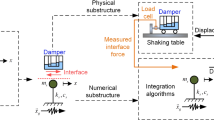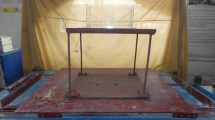Abstract
Tuned liquid damper (TLD) and tuned liquid column damper (TLCD) are two types of passive control devices that are widely used in structural control. In this study, a real-time hybrid simulation (RTHS) technique is employed to investigate the difference in control performance between TLD and TLCD. A series of RTHSs is presented with the premise of the same liquid length, mass ratio, and structural parameters. Herein, TLD and TLCD are physically experimented, and controlled structures are numerically simulated. Then, parametric studies are performed to further evaluate the different performance between TLD and TLCD. Experimental results demonstrate that TLD is more effective than TLCD under different amplitude excitations.
Similar content being viewed by others
References
Ashasi-Sorkhabi A, Malekghasemi H and Mercan O (2015), “Implementation and Verification of Real-Time Hybrid Simulation (RTHS) Using A Shake Table for Research and Education,” Journal of Vibration and Control, 21 (8): 1459–1472.
Ashasi-Sorkhabi A, Malekghasemi H, Ghaemmaghami A and Mercan O (2017), “Experimental Investigations of Tuned Liquid Damper-Structure Interactions in Resonance Considering Multiple Parameters,” Journal of Sound and Vibration, 388: 141–153.
Bigdeli Y and Kim D (2016), “Damping Effects of the Passive Control Devices on Structural Vibration Control: TMD, TLC and TLCD for Varying Total Masses,” KSCE Journal of Civil Engineering, 20 (1): 301–308.
Bulian G, Souto-Iglesias AD and Louis BE (2010), “Smoothed Particle Hydrodynamics (SPH) Simulation of A Tuned Liquid Damper (TLD) with Angular Motion,” Journal of Hydraulic Research, 48: 28–39.
Chen C and Ricles JM (2012), “Large-Scale Real-Time Hybrid Simulation Involving Multiple Experimental Substructures and Adaptive Actuator Delay Compensation,” Earthquake Engineering and Structural Dynamics, 41: 549–569.
Frandsen JB (2005), “Numerical Predictions of Tuned Liquid Tank Structural Systems,” Journal of Fluids and Structures, 20 (5): 309–329.
Fujino Y, Pacheco BM, Chaiseri P and Sun LM (1988), “Parametric Studies on Tuned Liquid Damper (TLD) Using Circular Containers by Free-Oscillation Experiments,” Structuctural Engineering/Earthquake Engineering, 5 (2): 381–391.
Gao H, Kwok KCS and Samali B (1997), “Optimization of Tuned Liquid Column Dampers,” Engineering Structures, 19 (6): 476–486.
Gui Y, Wang JT, Jin F, Chen C and Zhou MX (2014), “Development of A Family of Explicit Algorithms for Structural Dynamics with Unconditional Stability,” Nonlinear Dynamics, 77 (4): 1157–1170.
Halabian A and Torki M (2011), “Numerical Studies on the Application of Tuned Liquid Dampers with Screens to Control Seismic Response of Structures,” The Structural Design of Tall and Special Buildings, 20 (2): 121–150.
Ikeda T (2003), “Nonlinear Parametric Vibrations of An Elastic Structure with A Rectangular Liquid Tank,” Nonlinear Dynamics, 33: 43–70.
Kaloop MR, Hu JW and Bigdeli Y (2017), “The Performance of Structure-Controller Coupled Systems Analysis Using Probabilistic Evaluation and Identification Model Approach,” Shock and Vibration, Article ID5482307.
Lee SK, Lee HR and Min KW (2012), “Experimental Verification on Nonlinear Dynamic Characteristic of A Tuned Liquid Column Damper Subjected to Various Excitation Amplitudes,” The Structural Design of Tall and Special Buildings, 21 (5): 374–388.
Lee SK, Park EC, Min KW, Lee SH, Chung L and Park JH (2007), “Real-Time Hybrid Shaking Table Testing Method for the Performance Evaluation of A Tuned Liquid Damper Controlling Seismic Response of Building Structures,” Journal of Sound and Vibration, 302 (3): 596–612.
Lu XZ, Han B, Hori M, Xiong C and Xu Z (2014), “A Coarse-Grained Parallel Approach for Seismic Damage Simulations of Urban Areas Based on Refined Models and GPU/CPU Cooperative Computing,” Advances in Engineering Software, 70: 90–103.
Marsh A, Prakash M, Semercigil E and Turan ÖF (2011), “A Study of Sloshing Absorber Geometry for Structural Control with SPH,” Journal of Fluids and Structures, 27 (8): 1165–1181.
Nakashima M and Masaoka N (1999), “Real-Time On-Line Test for MDOF Systems,” Earthquake Engineering and Structural Dynamics, 28: 393–420.
Sadek F, Mohraz B and Lew HS (1998), “Single- and Multiple-Tuned Liquid Dampers for Seismic Applications,” Earthquake Engineering and Structural Dynamics, 27: 439–463.
Reed D, Yu JK, Yeh H and Gardarsson S (1998), “Investigation of Tuned Liquid Dampers Under Large Amplitude Excitation,” Journal of Engineering Mechanics ASCE, 124 (4): 405–413.
Sakai F, Takaeda S and Tamaki T (1989), “Tuned Liquid Column Damper-New Type Device for Suppression of Building Vibration,” Proceedings of the International Conference on High-rise Buildings, Nanjing, China, 926–931.
Sun LM, Fujino Y, Chaiseri P and Pacheco BM (1992), “Modelling of Tuned Liquid Damper (TLD),” Journal of Wind Engineering and Industrial Aerodynamics, 43 (1–3): 1883–1894.
Sun LM, Fujino Y, Chaiseri P and Pacheco BM (1995), “The Properties of Tuned Liquid Dampers Using A TMD Analogy,” Earthquake Engineering & Structural Dynamics, 24 (7): 967–976.
Wakahara T, Ohyama T and Fujii K (1992), “Suppression of Wind-Induced Vibration of A Tall Building Using Tuned Liquid Damper,” Journal of Wind Engineering and Industrial Aerodynamics, 43 (1–3): 1895–1906.
Wallace M, Wagg D and Neild S (2005), “An Adaptive Polynomial Based Forward Prediction Algorithm for Multi-Actuator Real-Time Dynamic Substructuring,” Proceedings of the Royal Society A-Mathematical Physical and Engineering Sciences, 461 (2064): 3807–3826.
Wang JT, Gui Y, Zhu F, Jin F and Zhou MX (2016), “Real-Time Hybrid Simulation of Multi-Story Structures Installed with Tuned Liquid Damper,” Structural Control and Health Monitoring, 23 (7): 1015–1031.
Yu JK, Wakahara T and Reed D (1999), “A Non-Linear Numerical Model of the Tuned Liquid Damper,” Earthquake Engineering & Structural Dynamics, 28 (6): 671–686.
Zhu F, Wang JT, Jin F and Lu LQ (2016), “Seismic Performance of Tuned Liquid Column Dampers for Structural Control Using Real-Time Hybrid Simulation,” Journal of Earthquake Engineering, 22 (8): 1370–1390.
Zhu F, Wang JT, Jin F and Lu LQ (2017), “Real-Time Hybrid Simulation of Full-Scale Tuned Liquid Column Dampers to Control Multi-Order Modal Responses of Structures,” Engineering Structures, 138: 74–90.
Zhu F, Wang JT, Jin F, Zhou MX and Gui Y (2014), “Simulation of Large-Scale Numerical Substructure in Real-Time Dynamic Hybrid Testing,” Earthquake Engineering and Engineering Vibration, 13: 599–609.
Acknowledgement
This research is financially supported by the National Natural Science Foundation of China (Nos. 51725901 and 51639006). The authors express sincere gratitude for their support.
Author information
Authors and Affiliations
Corresponding author
Additional information
Supported by
National Natural Science Foundation of China under Grant Nos. 51725901 and 51639006
Rights and permissions
About this article
Cite this article
Fei, Z., Jinting, W., Feng, J. et al. Control performance comparison between tuned liquid damper and tuned liquid column damper using real-time hybrid simulation. Earthq. Eng. Eng. Vib. 18, 695–701 (2019). https://doi.org/10.1007/s11803-019-0530-9
Received:
Accepted:
Published:
Issue Date:
DOI: https://doi.org/10.1007/s11803-019-0530-9




